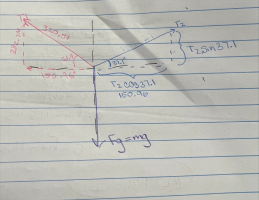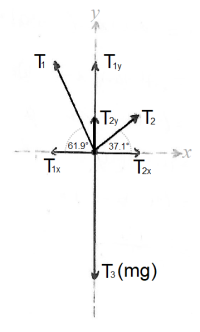Amelinator
New member
- Joined
- Feb 1, 2024
- Messages
- 16
Hi (again) @Amelinator,View attachment 37194
So far, I've found the X and Y components of 61.9 deg. I'm not sure where to go from here to find tension 2.
Sadly, my physics class is completely onlineHi (again) @Amelinator,
You seem to be posting rather a lot of Physics questions in here. You do know this is a Maths forum, don't you? Maybe you would be better off posting your questions in a forum devoted to Physics itself?
I happen to have taught both Maths and Physics (at HS level) for thirty years and there are some others in here who have extensive expertise in Physics too but I'm beginning to be concerned that you're just getting us to do all your Physics homework for you!
Though this question does (again) seem to be from some kind of online test?
Are you doing only a (completely) online course in Physics?
Do you not have any face to face teaching time?
We can offer you assistance on the questions you post but there's no substitute for proper teaching of a subject. If there's something you don't understand or know how to tackle then you should really ask a teacher or tutor to explain it to you in detail rather than just getting us to guide you to the solution.
I'm afraid you may not get everything you really need to progress in the subject area from the assistance offered in a forum like this.
However, the problem you are having with this question is because you haven't done something that is very important with many, if not most, Physics problems involving forces!
In addition to your sketch of the problem (that I have replicated here because (IMNSHO) it is better supplied as a picture rather than the PDF file you uploaded)...
...you need to draw a Free Body Diagram (FBD) to 'enhance' your understanding of the situation and provide the necessary insight to solve the problem given.
Your drawing simply replicates the picture that the question already provided but the FBD analyses that situation and shows you how to proceed.
Here is a FBD of a similar situation to the one you have been given...
You know that the system is in equilibrium (ie: the sign is stationary) so all the forces must be in balance.
You have been able to calculate the forces acting in the x- & y- directions due to the tension in the left rope but, since the forces in the x- & y- directions must balance then the force in the x-direction due to the right rope must be equal (and opposite) to that produced by the left rope.
Now you know the force in the x-direction due to the right rope, you can calculate the tension in that rope and, thence, the force in the y-direction due to that rope's tension.
Thus you now know all the upward (y-direction) forces acting on the sign and can therefore calculate its mass assuming whatever value you've been told to use for the gravitational field strength (usually 9.81 ms-2 or 10 ms-2).
Please now draw your own FBD and calculate the required answers then come back and show us a picture of your work.
Please don't just come back and say you put the right answers in online and they were marked correct (at your eighth attempt!).
Hope that helps.
Ok, so I've drawn my FBD. I can see what to do for the next steps! The next thing I will do is use the Fnet=ma equation for the x component of T2.Hi (again) @Amelinator,
You seem to be posting rather a lot of Physics questions in here. You do know this is a Maths forum, don't you? Maybe you would be better off posting your questions in a forum devoted to Physics itself?
I happen to have taught both Maths and Physics (at HS level) for thirty years and there are some others in here who have extensive expertise in Physics too but I'm beginning to be concerned that you're just getting us to do all your Physics homework for you!
Though this question does (again) seem to be from some kind of online test?
Are you doing only a (completely) online course in Physics?
Do you not have any face to face teaching time?
We can offer you assistance on the questions you post but there's no substitute for proper teaching of a subject. If there's something you don't understand or know how to tackle then you should really ask a teacher or tutor to explain it to you in detail rather than just getting us to guide you to the solution.
I'm afraid you may not get everything you really need to progress in the subject area from the assistance offered in a forum like this.
However, the problem you are having with this question is because you haven't done something that is very important with many, if not most, Physics problems involving forces!
In addition to your sketch of the problem (that I have replicated here because (IMNSHO) it is better supplied as a picture rather than the PDF file you uploaded)...
...you need to draw a Free Body Diagram (FBD) to 'enhance' your understanding of the situation and provide the necessary insight to solve the problem given.
Your drawing simply replicates the picture that the question already provided but the FBD analyses that situation and shows you how to proceed.
Here is a FBD of a similar situation to the one you have been given...
You know that the system is in equilibrium (ie: the sign is stationary) so all the forces must be in balance.
You have been able to calculate the forces acting in the x- & y- directions due to the tension in the left rope but, since the forces in the x- & y- directions must balance then the force in the x-direction due to the right rope must be equal (and opposite) to that produced by the left rope.
Now you know the force in the x-direction due to the right rope, you can calculate the tension in that rope and, thence, the force in the y-direction due to that rope's tension.
Thus you now know all the upward (y-direction) forces acting on the sign and can therefore calculate its mass assuming whatever value you've been told to use for the gravitational field strength (usually 9.81 ms-2 or 10 ms-2).
Please now draw your own FBD and calculate the required answers then come back and show us a picture of your work.
Please don't just come back and say you put the right answers in online and they were marked correct (at your eighth attempt!).
Hope that helps.
Is this correct? T2= 189.3 NOk, so I've drawn my FBD. I can see what to do for the next steps! The next thing I will do is use the Fnet=ma equation for the x component of T2.
Again, I'm sorry that I am seeking advice on this forum, as I just thought physics was applied math. I will relocate to a different forum, as my content area is not meant to be posted here.
Looks correct to me.Is this correct? T2= 189.3 N
Please don't think that I am trying to chase you away! You are welcome to post your problems in this forum and there is always likely to be someone with the Physics expertise around to address your queries.I'm sorry that I am seeking advice on this forum, as I just thought physics was applied math. I will relocate to a different forum, as my content area is not meant to be posted here.
I am fairly sure that what I've highlighted above (in red) was just a 'slip of the pen' and you meant to write that F = ma would be used to get the mass of the sign.Ok, so I've drawn my FBD. I can see what to do for the next steps! The next thing I will do is use the Fnet=ma equation for the x component of T2.


Your final answer there is correct (as rounded to 1 decimal place) though I get a different answer (from the "189.27N" in your picture) due to a rounding error you have made at some intermediate stage. You should only ever round your results at a final answer; the more you use values that you have rounded in subsequent calculations, the greater the final error will be at the end! Modern calculators allow you to store intermediate results such that, with a bit of judicious sequencing, you don't have to round anything until you reach a final answer (in most situations).Is this correct? T2= 189.3 N
